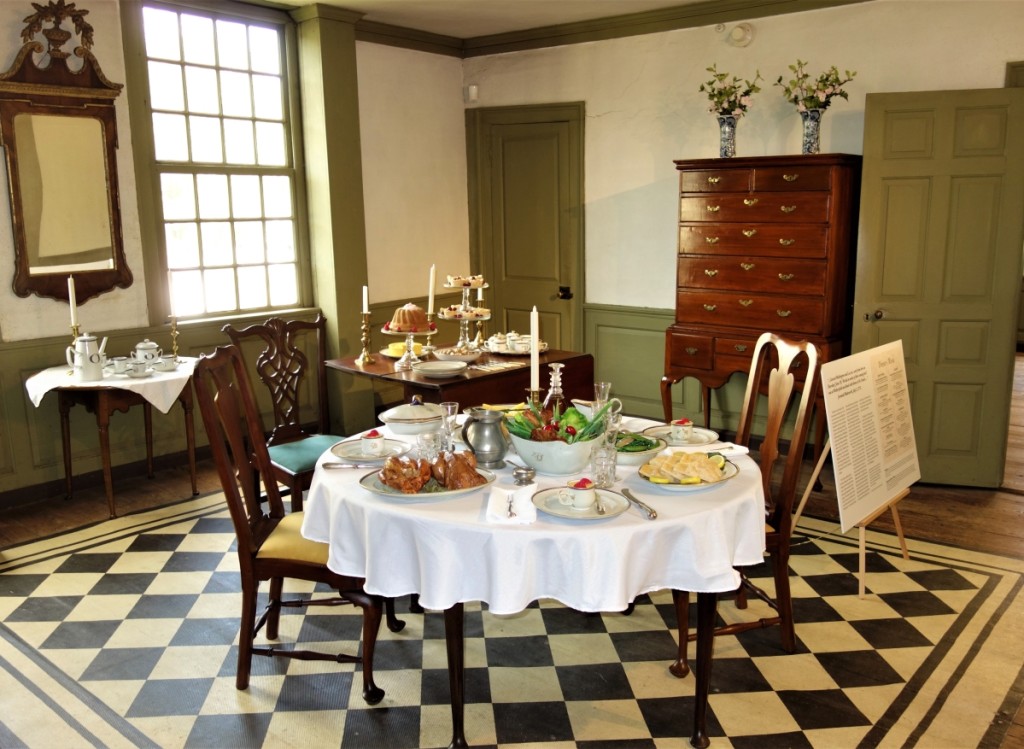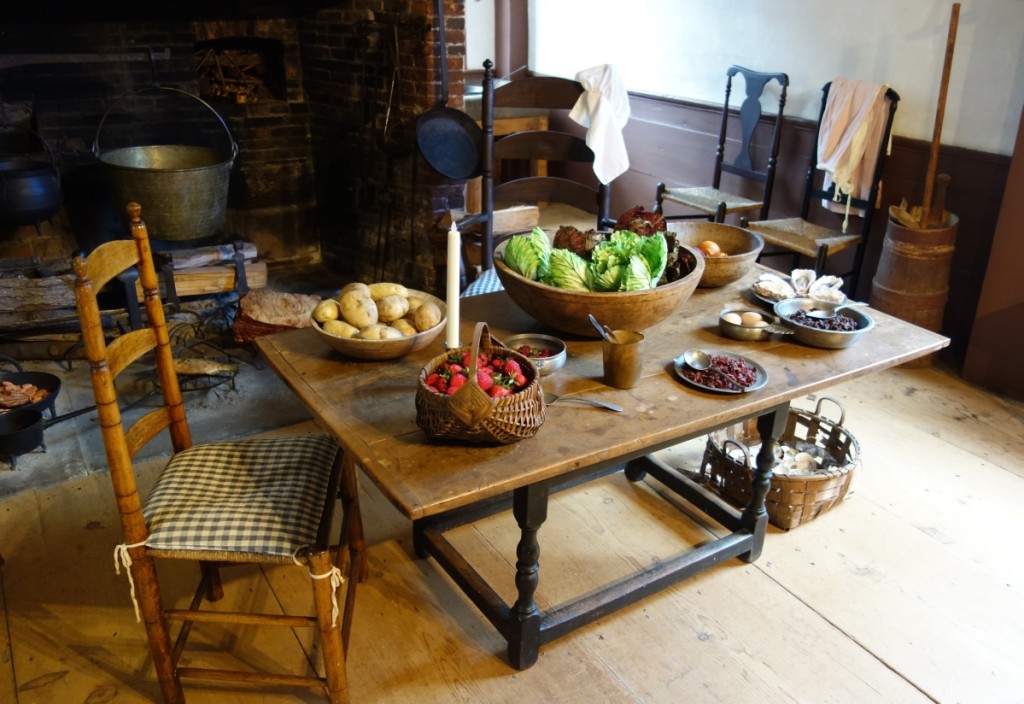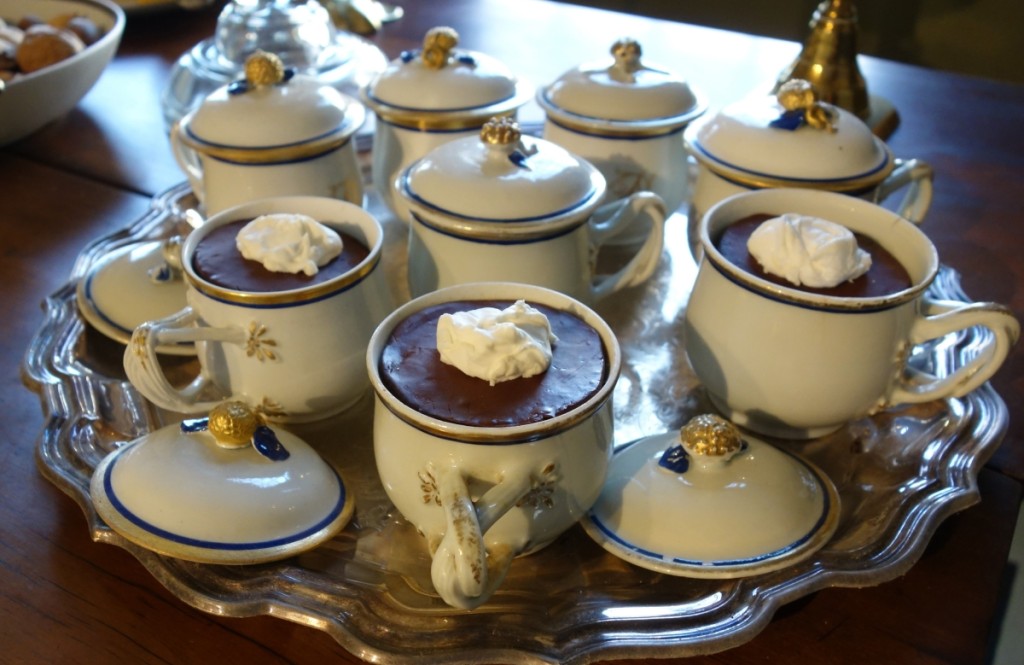WETHERSFIELD, CONN. – On long-term view at the Webb-Deane-Stevens (WDS) Museum is a special interpretation and exhibit of a little-known, but historic dinner held for General George Washington at the home of Silas and Elizabeth Deane on June 29, 1775. The Deane House is one of the three historical Wethersfield houses that now comprise WDS.
Using their most ingenious food-styling techniques and a tremendous amount of research, executive director Charles Lyle and several staff members have painstakingly recreated the sort of midday meal they believe Washington would have enjoyed at the Deane House, using circa 1770s recipes that feature seasonal food available in Connecticut at the beginning of the Revolutionary War.
The dinner was occasioned by the new commander-in-chief traveling to Cambridge, Mass., from Philadelphia to take control of the Continental Army. Washington would return to the site in 1781 for his historic stay at the home of Joseph Webb, for which WDS is renowned.
The best-known evidence of the dinner having taken place is a letter written on July 2, 1775, by Jeremiah Wadsworth, the Commissary of the Connecticut Militia, in charge of supplying food and supplies for the Connecticut troops at Camp Cambridge. “General Washington and (Major General) Lee, etc, went from here (Hartford) on Thursday (June 29). We had no notice of their coming, but I was at Weathersfield and dined with them at Mr Dean’s; notified the Committee here of their approach…”
According to Lyle, it was this initial meeting between Washington and Wadsworth that helped to forge a long working relationship between the two men that lasted through the war. “Wadsworth was Commissary of the Connecticut Militia in 1775 and later appointed Deputy Commissary-General of Purchases for the Continental Army and then Commissary-General,” Lyle says. “It was thanks to Wadsworth’s influence that Washington designated Connecticut as ‘The Provision State.’ Connecticut, the third-smallest colony, supplied more cannons and food for Washington’s army than any other.”
Accompanying Washington to Massachusetts was his second in command, Major General Charles Lee, and other attending troops. Silas Deane remained in Philadelphia to work on various congressional committees, but invited Washington to stop at his house while en route to Cambridge for dinner or to lodge for the night.
Deane wrote to his wife Elizabeth to inform her that he had invited Washington to stop at their home during his travels. “He promises me to call, and if it happen favorable, to spend one night with you.” Silas had come to know Washington in Congress and committee and had developed a great admiration for him. “I wish to cultivate this gentleman’s acquaintance and regard, not from any sinister views, but from the great esteem I have of his virtues, which do not shine in the view of the world, by reason of his great modesty, but when discovered by the discerning eye, shine proportionally brighter.”
The Deane House dining parlor features the recreated dinner, which, in the Eighteenth Century, was the main meal of the day and served in the afternoon. The dinner was not a social occasion but provided the officers the opportunity to meet in private to talk politics and discuss the pressing business of organizing and supplying the Continental Army.
Deane wanted his wife to make a good impression on Washington. In his letter of June 16, he wrote: “I know you will receive him as my friend, and what is more – infinitely more – his Country’s friend.”
The Deanes were wealthy, and the menu aptly reflects this. Leafy greens, vegetables and berries would have been picked from the kitchen garden, the bread and pound cake were baked in the bake oven, chickens were from the farmyard. Fish was likely procured from a Connecticut River fisherman or a local market. Out-of-season items such as turnips, onions and potatoes would have been stored in the cellar from the previous season.
The meal is served using a set of circa 1770 Chinese porcelain that includes plates, platters, coffee and tea services and a variety of serving dishes. As was the practice of the period, the meal is set out on a white linen tablecloth and desserts are displayed on a nearby table. Several dishes included in the menu are known to be Washington’s favorites.
Charged with recreating a meal that could be displayed for months, Linda Pagliuco and Elizabeth O’Brien, longstanding educators and guides at WDS, used a few decidedly contemporary materials to craft some of the faux food, making sure none of the materials stained the antique porcelain or stemware.
Among Pagliuco’s clever creations are delicious-looking peas – made from sculpting clay sprayed with glossy varnish. In recreating the elegant punch, she needed to create two layers of glycerin soap so the raspberries that appear to float on top are partially submerged. She employed candle wax colored with cinnamon and curry powder to create the “mustard sauce” on the dining table.
A talented baker whose creations often appear throughout the museum’s three historic homes, O’Brien crafted the cherry tarts, and used an old New England recipe to make the honey-wheat bread. She created the “strawberry cream” served with dessert from tinted royal icing, which hardens and lasts seemingly forever.
And a note of caution to those considering a tour of the exhibit, resist any temptation to try a nip of the “Madeira” on display…it is mouthwash.
The kitchen in the Deane House portrays the preparations for Washington’s repast, with leafy greens gathered for a salad, strawberries in a basket, fresh bread and more. Small touches, such as a period dough box create a feeling of authenticity.
As was customary in the 1700s, Elizabeth probably did not join the guests, though she would have checked on them during the dinner service. She would have directed her servants and made certain her guests were properly served. In the recreation, a fourth chair is placed to the side for Elizabeth to sit whenever she came into the room for short visits throughout the dinner. She may have joined the gentlemen for dessert and a farewell toast.
The Menu
First Course
Rice custard pudding with fresh berries: in Eighteenth Century New England, a cooked fruit, custard, cornmeal or bread pudding was often served as an appetizer.
Honey-wheat bread with fresh butter: cream was plentiful in June to make butter, since the cows were producing milk after having their calves.
Second Course
Filet of fish freshly caught from the nearby Connecticut River. Washington was particularly fond of shad, but it was probably not available as late as June 29.
Roast Chicken: the chicken would have been roasted on the spit in the kitchen fireplace.
Watermelon rind relish and mustard sauce: fish and meat were accompanied by salt, pepper, sauces, relish and chutney.
Leafy greens sallet (Salad) with herb vinegar dressing: made with fresh lettuce and other garden vegetables from the Deane kitchen garden.
Minted pease (peas): one of Washington’s favorite dishes.
Dressed asparagus: Recipes for asparagus are found in cookbooks of the period.
Creamed turnips, onions and potatoes: the dish resembles today’s scalloped potatoes and was made with fresh cream and vegetables stored in the cellar from the previous season.
Dessert
Buttermilk pound cake with strawberry cream: pound cake was made with a pound each of flour, butter, sugar and eggs. Buttermilk helped leaven the cake. The topping was whipped cream flavored with strawberry juice.
Cherry tarts: native cherry trees produced the sour fruit in June. The tarts are displayed on stacked glass salvers in the style of the Eighteenth Century.
Chocolate custard pudding with whipped cream: served in individual custard cups, a form that was popular in the Eighteenth Century.
Cheese and nuts: Washington purportedly broke many a tooth on his favorite after-dinner snack.
Coffee: Nationalist sentiment made coffee a popular and patriotic drink during the American Revolution in lieu of boycotted tea.
Cyder (hard cider): hard apple cider was New England’s primary drink made in bulk with most farmers cultivating their own orchards and making the drink themselves. Since water was often polluted, ale, beer, hard cider, wine and distilled spirits were all deemed healthier alternatives to water.
Madeira: the fortified wine was Washington’s favorite alcoholic beverage. It was considered a patriotic option as it wasn’t taxed by the British.
The Webb-Deane-Stevens Museum is at 211 Main Street. For information, 860-529-0612 or www.webb-deane-stevens.org.

-1024x741.jpg)






